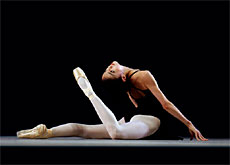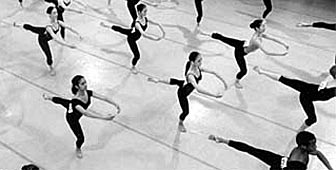Young talents hope to dance to success

Switzerland's prestigious dance competition, the Prix de Lausanne, aims to encourage new talent and find the ballet stars of tomorrow.
A total of 66 young dancers from all over the world are expected to take part in this year’s event, which starts on Monday.
The six-day competition is open to dancers of all nationalities aged 15-17 who are not yet professionals.
The winners are usually awarded scholarships to some of the most famous ballet schools and companies worldwide, including the Royal Ballet in London and the Béjart Ballet in Lausanne.
This year 50 girls and 16 boys have been accepted for the final stages of the competition.
“The specificity of the Prix de Lausanne, compared with other ballet competitions, is that we look out for the best potential talents, whom we reward with scholarships to finish their training,” said Patricia Leroy, the secretary-general of the Prix de Lausanne.
“Other ballet competitions often simply reward somebody for having danced well on a certain day, on a certain stage, with an amount of money,” she told swissinfo.
An overall winner – the dancer who gains the most points – is also announced. Laureates receive funding to help with their studies.
In all, the event has awarded around 144 scholarships in its 33-year history and can count many big names of the dancing world among its former winners.
These include the Royal Ballet’s Carlos Acosta and Alina Cococaru, as well as José Martinez and Laetitia Pujol from the Paris Opera.
More than prizes
But Leroy is quick to stress that the competition is not just about the prizes.
“We try to consider a dancer as a whole person and not just as a dancer, and therefore during the week of the competition we offer different services to our candidates,” she explained.
She said every dancer who didn’t reach the finals received help and advice on what should be improved.
In addition, all the hopefuls receive coaching and feedback from well-known principal dancers, with the aim of improving artistry and stage presence.
Another preoccupation of the Prix is the dancers’ health.
“What has been going on in the past years among dancers, and also in society as a whole, is that there are more eating disorders and we want to fight this,” Leroy said.
“One of the consequences is osteoporosis, which unfortunately affects some dancers already from the age of 14, so we’ve instigated counselling and our doctor interviews candidates who he thinks may have problems in the future.”
Experts also give advice to ballet teachers on how to train dancers without causing too much damage to the body, as well as seminars on how to manage stage stress and how to do stage make-up.
The idea is that everybody who attends the competition should come away with new insights and knowledge, explained Leroy.
Changes
This year sees a few changes to the event. For the first time, the preliminary round of the competition took place in advance via video selection.
One of the reasons for this was that some good candidates did not have the necessary funds to travel to Lausanne for the first rounds of the Prix.
The participants also had to learn the classical variations at home on the basis of a video containing solos performed by well-known dancers. In all, candidates have to present two classical variations and one contemporary variation.
However, despite the change in selection procedures, this year’s event has, as ever, a strong Asian presence, with a large contingent of dancers from Japan, Korea and China. There are no Swiss in competition this year.
“Asian dancers are really good and they have this ability to concentrate, this intensity in their will to improve which maybe we’re starting to lack a little bit in the western part of the world,” admitted Leroy.
The results of the Prix will be announced on January 29 in Lausanne’s Théâtre de Beaulieu.
In the meantime, Leroy said that she was looking forward to a week of excitement and unpredictability.
“It’s like when you cross the ocean on a big steamer. Everybody comes in at the beginning and everybody knows where it goes in the end,” she explained.
“In the meantime, there are so many things happening, so many hopes, disappointments, discoveries and feelings of happiness. During a week it’s like a world in itself.”
swissinfo, Isobel Leybold-Johnson
The Prix de Lausanne was founded in 1973 by Philippe and Elvire Braunschweig.
Among the prizes awarded are three or four scholarships at a dance school and three or four for a major international dance company.
A “Hope” prize is given to young competitors aged 16 or under.
A prize is also awarded for contemporary dance.
This year, for the first time, the preliminary round of the competition took place in advance via video selection.
Another change this year is that for the contemporary section dancers will have a choice of two solos by the choreographer Jiri Kylian.
The Prix will also open up several events to the public.
The competition has said that it is aiming to attract a larger audience and more sponsorship. It has said it has been suffering from financial pressures over the past few years.

In compliance with the JTI standards
More: SWI swissinfo.ch certified by the Journalism Trust Initiative











You can find an overview of ongoing debates with our journalists here . Please join us!
If you want to start a conversation about a topic raised in this article or want to report factual errors, email us at english@swissinfo.ch.